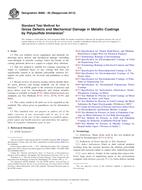We need your consent to use the individual data so that you can see information about your interests, among other things. Click "OK" to give your consent.
ASTM B866-95(2013)
Standard Test Method for Gross Defects and Mechanical Damage in Metallic Coatings by Polysulfide Immersion
STANDARD published on 1.12.2013
The information about the standard:
Designation standards: ASTM B866-95(2013)
Note: WITHDRAWN
Publication date standards: 1.12.2013
SKU: NS-8535
The number of pages: 4
Approximate weight : 12 g (0.03 lbs)
Country: American technical standard
Category: Technical standards ASTM
The category - similar standards:
Annotation of standard text ASTM B866-95(2013) :
Keywords:
electrodeposits, gross defects, mechanical damage, metallic coatings, polysulfide immersion, porosity testing, wear-through, ICS Number Code 25.220.40 (Metallic coatings)
Additional information
| Significance and Use | ||||||||||||||||||||||||||||||
|
5.1 The purpose of the alkaline polysulfide immersion test is to determine the presence of mechanical damage, wear-through, and other gross defects in the coating. Most metallic coatings are intended to be protective and the presence of gross defects indicates a serious reduction of such protection. 5.2 The protection afforded by well applied coatings may be diminished by improper handling following plating or as a result of wear or mechanical damage during testing or while in service. The alkaline polysulfide test serves to indicate if the damage has extended down to the copper or copper alloy basis metal since it will not detect exposed nickel underplate. 5.3 The alkaline polysulfide test has been specified in several ASTM specifications for tin-plated coatings, namely Specifications B246 and B545. This test could also be used to detect gross defects and mechanical damage in other metallic coatings, such as tin-nickel alloy (Specification B605), nickel (Specification B689), gold (Specification B488), palladium (Specification B679), and autocatalytic nickel-phosphorous coatings (Specification B733). 5.4 This test detects mechanical damage that exposes copper underplate and copper basis metal. Such damage may occur in any post-plating operation or even towards the end of the plating operation. It is most often seen to occur in product assembly operations. 5.5 If properly performed, this test will also detect wear-through, provided the wear-through reaches a copper or copper-alloy layer. 5.6 Many types of gross defects are too small to be seen, except at magnifications so high (as in SEM) that a realistic assessment of the measurement area cannot be easily made. Other defects, such as many types of wear-through, provide insufficient contrast with the coating surface. Gross defects tests (as with porosity tests) are, therefore, used to magnify the defect sites by producing visible reaction products in and around the defects. 5.7 The polysulfide solution will react with copper and copper alloys to produce a dark brown or black stain (the defect indications) at the site of the defect. Silver also turns black under the same conditions. The test solution will not react with nickel and is only useful when the presence or absence of copper exposure is a specific requirement. 5.8 The polysulfide immersion test is relatively insensitive to the presence of small pores. It shall not be used as a general porosity test. (Test Method B809 should be used instead.) 5.9 The extent and location of the gross defects or mechanical damage (revealed by this test) may or may not be detrimental to product performance or service life. Such determinations shall be made by the user of the test through practical experience or judgment. 5.10 The present test can be used on samples of various geometries, such as curved surfaces. It can also be used for selective area coating if allowance is made for tarnish creepage from bare copper alloy areas. 5.11 This test is destructive in that it reveals the presence of gross defects by contaminating the surface with reaction-product films. Any parts exposed to this test shall not be placed in service. 5.12 However, the defect indications on the sample surfaces that result from this test are stable; samples may be retained for reference purposes. 5.13 This test is neither recommended for predictions of product performance nor is it intended to simulate field failure mechanisms. For such product performance evaluations, an environmental test that is known to simulate actual failure mechanisms should be used. |
||||||||||||||||||||||||||||||
| 1. Scope | ||||||||||||||||||||||||||||||
|
1.1 This test method covers equipment and methods for detecting gross defects and mechanical damage (including wear-through) in metallic coatings where the breaks in the coating penetrate down to a copper or copper alloy substrate. 1.2 This test method is suitable for coatings consisting of single or combined layers of any coating that does not significantly tarnish in an alkaline polysulfide solution. Examples are gold, nickel, tin, tin-lead, and palladium, or their alloys. 1.3 Recent reviews of porosity testing (which include those for gross defects) and testing methods can be found in literature.2,3 An ASTM guide to the selection of porosity and gross defect tests for electrodeposits and related metallic coatings is available as Guide B765. Other related porosity test standards are Test Methods B735, B741, B798, B799, and B809. 1.4 The values stated in SI units are to be regarded as the standard. The values given in parentheses are for information only. 1.5 This standard does not purport to address all of the safety concerns, if any, associated with its use. It is the responsibility of the user of this standard to establish appropriate safety and health practices and determine the applicability of regulatory limitations prior to use. |
||||||||||||||||||||||||||||||
| 2. Referenced Documents | ||||||||||||||||||||||||||||||
|
Similar standards:
Historical
1.6.2010
Historical
1.11.2011
Historical
15.6.2014
Historical
1.6.2012
Historical
1.4.2012
Historical
1.10.2010
We recommend:
Technical standards updating
Do you want to make sure you use only the valid technical standards?
We can offer you a solution which will provide you a monthly overview concerning the updating of standards which you use.
Would you like to know more? Look at this page.



 ASTM D4584-05(2010)..
ASTM D4584-05(2010).. ASTM D6492-99(2011)..
ASTM D6492-99(2011).. ASTM D7639-10(2014)..
ASTM D7639-10(2014).. ASTM D7803-12
ASTM D7803-12 ASTM E1659-12
ASTM E1659-12 ASTM E2354-10
ASTM E2354-10
 Cookies
Cookies
